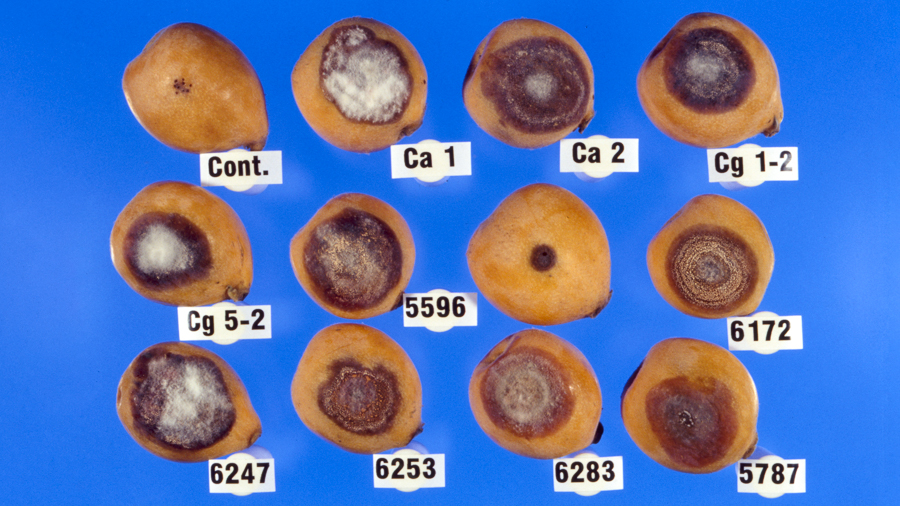Approved strains

At the NARO Genebank, approved strains for distribution are being selected based on the phylogenetic analyses of DNA sequences of some gene regions for their identification, as well as on the microscopic inspection of their cultural characteristics.
- Approved Strains of Fusarium species
Recently molecular-phylogenetic studies on the species of the genus Fusarium and its allies based on comparative analyses of DNA sequences were much progressed. Many species within the genus were found to be species-complexes containing plural cryptic (hidden) species within their specific circumscription. Division of these species or their redefinition is also in progress. The NARO Genebank has been performing DNA sequence analyses such as Histone H3 gene region, mitochondrion small-subunit ribosomal DNA (mtSSU rDNA), ribosomal DNA (rDNA) ITS regions (including partial sequences of 18S rDNA, ITS1, 5.8S rDNA, ITS2, partial sequences of 28S rDNA), as well as examining their cultural phenotypic characters. It was for the purpose to establish a set of typical Japanese strains of Fusarium species based on the current taxonomic basis. Typical strains which represent individual species were selected as “the Approved Strains for Distribution” of Fusarium species. - Approved Strains of Colletotrichum species
Several researchers published papers on re-classification of the genus Colletotrichum based on molecular phylogenetic studies during this century. They clarified that many conventional species of the genus defined by morphology consisted of plural phylogenetic species, with the establishment of new species and combinations. Many strains of the genus preserved in the NARO Genebank were re-identified based on partial sequences of so called barcode genes such as rDNA-ITS, β-tubulin-2 and Histone H3, and some of them with typical characters to each species were selected as the approved strains. Pending species and groups of the genus Colletotrichum are also examined and re-classified at present. More approved strains will be added according to the latest information. - Approved strains of phytopathogenic Rhizobium species (formerly Agrobacterium species)
In the case of the genus Agrobacterium, which comprises crown gall bacteria and hairy root bacteria, the genus and species have been artificially defined based on pathogenic characters. For some species of the genus, several biovars, equivalent to the rank of variety level, have been established. Recently, based on the results of polyphasic taxonomic approaches, it was proposed that each biovar should be elevated to the species level (Sawada et al., 1993; Ophel and Kerr, 1990), and that the genera Agrobacterium and Rhizobium should be amalgamated into one single genus Rhizobium (Young et al., 2001). Taking these changes in the taxonomic situation into consideration, strains belonging to the phytopathogenic Rhizobium species (formerly Agrobacterium species) preserved in the NARO Genebank were re-identified based on phylogenetic analyses using 16S rDNA, atpD, glnA and recA, inoculation tests, PCR assays and so on, and some of them with typical characters for each species/pathogenic state/genomovar were selected as the approved strains (reference strains for taxonomic studies). In addition, for every host plant, we chose pathogenic strains that were proved to harbor Ti or Ri plasmids, as the approved strains (reference strains for inoculation tests). - Approved strains of kiwifruit bacterial canker pathogens (Pseudomonas syringae pv. actinidiae)
In many kiwifruit-producing countries including Japan, bacterial canker disease has become a serious problem, causing major damage. The causal bacterium (Pseudomonas syringae pv. actinidiae) is now classified into five biovars (biovars 1, 2, 3, 5 and 6) based on the differences in various phenotypes and genotypes. In addition, it is becoming clear that repertories of pathogenicity-related genes and virulence toward kiwifruit differ among biovars. Of these, four biovars (biovars 1, 3, 5 and 6) have been confirmed to exist in Japan, causing canker disease on Actinidia chinensis, A. deliciosa and A. arguta.
The NARO Genebank has a lot of strains belonging to the four biovars confirmed to exist in Japan. They were characterized based on phenotypic tests, PCR assays, MLSA and comparative genome analyses, showing that some biovars have extremely rich variation and can be subdivided into several groups. Therefore, for each biovar/group, we chose some strains with typical characteristics as the approved strains and decided to show them here with related information. - Approved strains of the soft rot-causing species derived from Pseudomonas marginalis sensu lato
Until recently, bacterial strains exhibiting the following properties had been identified as Pseudomonas marginalis in the field of plant disease control: fluorescent, oxidase-, potato soft rot-, and arginine dihydrolase-positive, soft rot-causing (referred to as “P. marginalis sensu lato” here). On the other hand, in recent years, as the phylogenetic and genomic analyses have been introduced into the bacterial taxonomy, it has become clear that P. marginalis sensu lato is heterogeneous, suggesting that it might be a species complex including many cryptic species.
In 2017, a preliminary survey was performed, targeting the P. marginalis sensu lato strains preserved in the NARO Genebank, to sort them into strains corresponding to “P. marginalis sensu stricto” (= strains included in the same species range as the type strain of P. marginalis) and strains that might not fit this category. Subsequent examination of the taxonomic affiliations of the latter using a polyphasic approach confirmed that a part of them differ from any known species, for which we have proposed the following eight novel species: P. aegrilactucae, P. allii, P. brassicae, P. cyclaminis, P. kitaguniensis, P. lactucae, P. morbosilactucae, and P. petroselini. In contrast, among the latter, some strains have been found to correspond to the “known species other than P. marginalis sensu stricto” (e.g., P. grimontii, P. salomonii, etc.). Therefore, for each species mentioned above, we chose some strains with typical characteristics as the approved strains and decided to show them here with related information.
Title
Toast message.